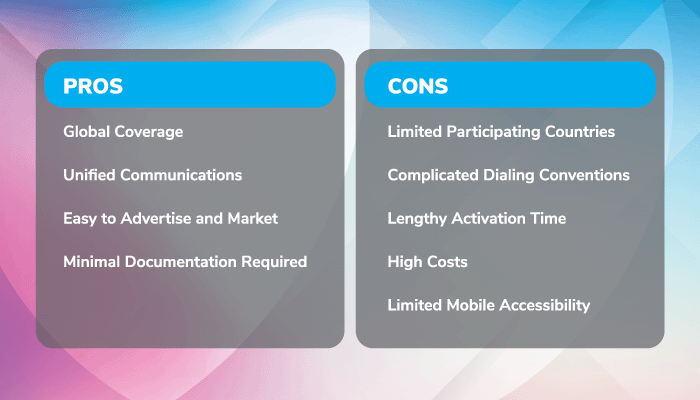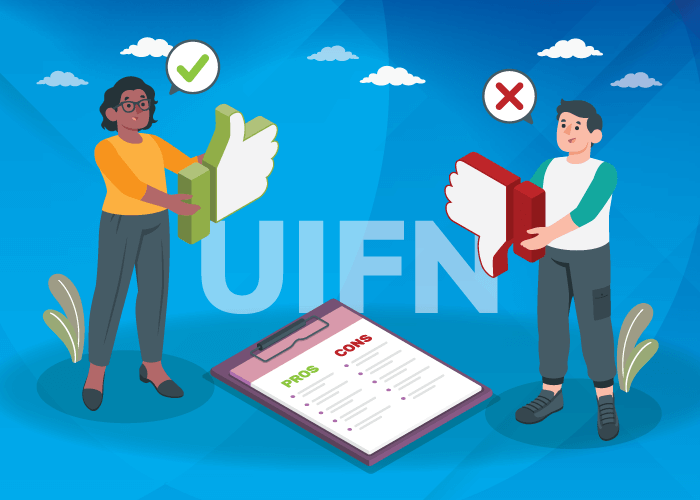For businesses with a global base, keeping communications unified could be challenging. For instance, maintaining separate phone lines for each business region might create communication silos.
Universal international freephone numbers (UIFN) can work as a central bridge connecting your business to multiple continents. With UIFN, businesses can tap into a vast pool of potential customers, increasing sales and revenue opportunities. And customers in participating countries can easily contact your business for support through a single, familiar number.
In this article, we’ll delve into UIFN pros and cons and how these numbers work.
Using UIFNs for Business: Pros and Cons
The phone number type you choose for your business is a gateway to customer connections. It can influence how customers reach you, operating costs, and more. So, when considering international operations and expansion, a question arises: Is a universal international freephone number right for your business?
To determine if a UIFN is suitable for your communication needs, consider the nature of your business, target regions, budget, and customer outreach goals. In this article, we’ll go over the important UIFN pros and cons:

How Does UIFN Work?
UIFN offers a single, toll-free point of contact that can be dialed from multiple countries participating in the program. These toll-free numbers are assigned by the International Telecommunication Union (ITU). Customers living in participating nations must use a specific dialing format to call a UIFN number. The standardized format typically comprises a country’s exit code (e.g., 00, 011), followed by the UIFN number, which is 800 and an 8-digit global subscriber number (GSN).
For example, in the UK, you would dial 00800 xxxx xxxx, and in Australia, you would dial 011800 xxxx xxxx.
UIFN Benefits
You can do a myriad of things with UIFN international freephone numbers, from centralizing communication to improving customer accessibility. Let’s take a look at the pros of using UIFN for your global communication strategy:
1. Expansive Global Coverage
One of the biggest advantages of UIFN is its global reach. Businesses can serve customers across a broad international spectrum (about 60 countries) with a single phone number.
Luke Genoyer, Business Development Manager at United World Telecom, explains that UIFN is beneficial for companies wishing to have a single phone number that covers a whole region like Europe or APAC. For example, he adds, “It works particularly well as a toll free number for EU countries because the dial-out prefix is the same for most of those countries.” So if businesses want to expand to Europe, then a UIFN will allow you to offer a single customer service number across European markets.
Below is the extensive list of countries where UIFN is available:
| Argentina | Australia | Austria | Belgium |
| Brazil | Bulgaria | Canada | China |
| Colombia | Costa Rica | Croatia | Cyprus |
| Czech Republic | Denmark | Estonia | Finland |
| France | French Guiana | Germany | Greece |
| Guadeloupe | Hong Kong | Hungary | Iceland |
| Israel | Italy | Japan | Korea South |
| Latvia | Lithuania | Luxembourg | Macao |
| Macedonia | Malaysia | Malta | Martinique |
| Mayotte | Moldova | Monaco | Netherlands |
| New Zealand | Norway | Peru | Philippines |
| Poland | Portugal | Reunion | Romania |
| Saint Pierre & Miquelon | Singapore | Slovakia | Slovenia |
| South Africa | Spain | Sweden | Switzerland |
| Taiwan | Thailand | United Kingdom | Uruguay |
For more global coverage and access, you may be benefit from our Toll Free FlexDial solution where you use a single phone number for global toll-free access. Chat with us to learn more or browse FlexDial prices.
2. Unified Number = Unified Contact
Juggling multiple phone numbers for different countries can be a nightmare for both you and your customers. Imagine the frustration of a customer in France trying to reach your US headquarters, only to find a confusing list of regional numbers. UIFN offers a single point of contact for several international locations. You can eliminate the complexity of managing multiple phone numbers.
3. Easy to Advertise and Market
A single toll-free number can aid your marketing and advertising efforts greatly. Businesses can do away with the complex web of regional phone listings and promote one number across global marketing campaigns. This consistency also reinforces brand recall, because customers have to remember one number on different marketing channels.
Several countries on the UIFN list share a dialing code. For instance, most European countries have the same dial-out code ‘00.’ This further simplifies branding and marketing efforts, as businesses can promote a single, memorable number without having to educate customers on different dialing procedures for each country.
4. Minimal Documentation Process
UIFN numbers are regulated by the ITU, guaranteeing a standardized and reliable service. According to Lusia Tsymbrovska, Carrier Relations Manager — while some regulations exist, obtaining a UIFN is relatively straightforward; minimal documentation is required, typically only necessitating basic company details like name and address.
And, you typically only need to register the UIFN in a minimum of two participating countries. This eliminates the complexity of managing separate regulations and applications for each targeted market. This streamlined process allows you to quickly activate your UIFN and start connecting with customers across borders.
UIFN Cons & Alternatives
While UIFN offers extensive benefits, it comes with certain limitations that businesses should consider. These include complex dialing conventions, lengthy activation times, and high costs. Let’s delve into these challenges in more detail:
1. Limited Participating Countries
While UIFN boasts impressive global reach, not all countries participate in the program. It’s possible that key target markets might be missing. For instance, Luke observes that UIFN is not an ideal solution for business in Latin America and the Middle East since only a few countries in those regions participate in the UIFN program.
In such cases, companies could opt for international toll free numbers. ITFN offers broader coverage, encompassing over 160 countries, including most remote locations. And since they’re toll-free numbers, customers can call them for free from within these countries, even if you forward those calls to your office in another region.
Another alternative is Toll-Free FlexDial which leverages advanced reverse-calling technology to provide worldwide toll-free access via one number.
2. Complicated Dialing Conventions
UIFN presents challenges due to complex dialing conventions across countries. Customers need to navigate a maze of dial-out codes and prefixes, specific to each country. This variability can confuse international callers, who may not be familiar with the UIFN format and its toll-free nature. It may prove difficult to educate customers from different countries on these conventions, possibly leading to missed connections.
3. Lengthy Activation Time
Unlike ITFS numbers, which can be typically activated within a few days (e.g, we can activate Australia numbers in one business day), UIFN requires registration on a country-by-country basis. This means that activation can take anywhere between 10 days to two months. If a speedy rollout is what you are looking for, then consider getting an ITFS number.
4. High Costs
UIFN cost structure is another major drawback. The actual breakdown depends on where you are buying your UIFN number. In most cases, there’s an initial one-time registration fee of $300. On top of that, you’ll also incur a setup fee for each country activation plus monthly subscription costs for using the service. This ongoing expense can add up, especially for companies requiring UIFN coverage in multiple countries.
In contrast, ITFS costs often follow a more flexible model, typically involving a provider subscription fee, additional phone number charges, and usage-based carrier fees. This structure can be more cost-effective for businesses with fluctuating call volumes or a need for targeted coverage in specific regions.
5. Limited Mobile Accessibility
Not all participating nations allow mobile accessibility to UIFN. In countries where mobile phone usage is high, this could restrict some customer segments. This is a crucial consideration, especially with forecasts suggesting that the number of mobile users worldwide is likely to rise to 7.49 billion by 2025.
Make an Informed Decision with UWT
If you are considering global expansion or are looking for a more universal contact number, getting a UIFN number could be an excellent starting point. And as you know by now, a UIFN offers a single point of contact for customers worldwide, centralizing communication.
With years of extensive experience, United World Telecom has garnered an understanding of the pros and cons of UIFN compared to alternatives like ITFS and Toll-Free FlexDial. We ensure businesses make the right choice for all their communication needs.
Need help deciding on a business phone number? Contact our experts today to discuss your specific business case and determine whether a UIFN is the right fit for your global ambitions.


